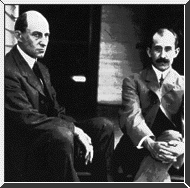 Wilber
Wright was born in 1867 on a farm
near Millville, Indiana. After struggling through his own medical
problems that started with a hockey accident in his last year of high
school, Wilber cared for his sick mother in her final years. He then
joined his brother, Orville, in his printing business that started a
partnership that would lead to the first heavier than air flight.
Unfortunately, Wilber died of typhoid fever on May 30, 1912, less
than ten years after that same successful flight.
Wilber
Wright was born in 1867 on a farm
near Millville, Indiana. After struggling through his own medical
problems that started with a hockey accident in his last year of high
school, Wilber cared for his sick mother in her final years. He then
joined his brother, Orville, in his printing business that started a
partnership that would lead to the first heavier than air flight.
Unfortunately, Wilber died of typhoid fever on May 30, 1912, less
than ten years after that same successful flight.
Orville Wright was born in 1871 and became a printers apprentice when he dropped out of high school. Afterwards he bought his own printing press and started a weekly newspaper, The West Side News. After the death of his brother, Orville soon left aviation and went into seclusion. When he died in January 1948, many people were shocked to hear that he had still been alive.
A gift similar to a helicopter to Wilber when he was eleven or twelve years old sparked an early passion for flight. In the early 1890s, Wilber became interested in flight again.
Yet it wasn't until the death of Otto Lilienthal, who had worked extensivly with gliders, in 1896 that the brothers pursued an active interest in piloted powered flight. They spent the next several years researching the past forty years of flight. They felt that there needed to be a more reliable way to control flight, rather than shifting the weight of the pilot which had been the method in the past. The Wrights created a method of control called wing warping in which the wings are twisted. They used their new design when constructing their first glider in 1900.
In 1901 the brothers tested a larger glider that flew 315 feet in 19 seconds. But this was not a successful year for them, and they almost decided to give up. They returned to their experiments and built a wind tunnel to test for the best shape of a wing. In 1902, using the data they had discovered, they built a biplane glider with a 32 foot wingspan. They made 50 glides by September and had their first crash. Orville crashed from an altitude of about 30 feet; however, that crash led them to attach the glider's wing warping controls over to a movable rudder. They also installed an elevator on the front of the aircraft to control the ascent and descent of the glider.
The next step for them was the propulsion system. The Wrights built their own 12 horsepower engine for flight. They couldn't use a propeller from a steamship, so they invented the first successful propeller for an aircraft. Once everything was installed, the Wrights returned to Kitty Hawk for testing. Orville and Wilber flipped a coin to see who would try the first flight on December 14, 1903. Wilber won, but he hit the ground after stalling on the first attempt. Orville tried successfully again three days later. The Flyer gently lifted into the air and flew for 12 seconds. The distance of that first flight was 120 feet. Wilber tried an hour later and flew 195 feet, and Orville's second flight took him 200 feet. Wilber's second flight of the day covered 852 feet and lasted 59 seconds. Had it not been for a strong gust of wind that tossed the Wright Flyer end over end, there may have been more attempts.
The press did not believe their accomplishment meant very much. The public and press were skeptical of flying a heavier than air craft after watching Samuel P. Langley's failures several months before. Over the next several years the Wrights continued to develop an operational aircraft and prove themselves. Meanwhile, they also battled for patent rights with several other inventors. The early death of Wilber took the Wrights out of aviation, as Orville did not continue for very much longer without his brother.
Designed by: H. Hansen
Walsh, E., John. (1975). One Day at Kitty Hawk.New York: Thomas Y. Crowell
Lopez, S., Donald. (1995). Smithsonian Guides Aviation.New York: Macmillan